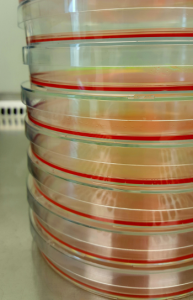Canada is among the 10 largest meat consumers per capita in the world, totalling approximately 155 lbs of meat per person per year. Globally, the environmental burden of current livestock farming practices is untenable: Livestock is a major cause of greenhouse gases, a chief consumer and polluter of water at every step in the meat-production chain, and responsible for the destruction of biodiversity through the occupation of land. Yet, meat has been part of our diet for thousands of years and meat consumption is endemic to every culture.
It is at the intersection of these two realities — our enormous appetite for meat and the absolute necessity to move away from current livestock practices — that the market of “clean meats” has been thriving. Clean meat or lab-cultured meat is true meat without the requirement to rear the full animal. Numerous start-ups have announced that their lab-grown meats are in production or will even reach the grocery store in the near future. This is in spite of the steep climb the clean-meat technology still has to make to decrease cost, increase production and achieve an authentic taste.
The quest for lab-grown meat is predicated on reverse-engineering “meat” tissue, utilizing the fundamental building block that is a muscle cell. The process starts out by sourcing the appropriate cells and growing them in the lab. Biopsies are taken from the animal whose meat is to be grown (the biggest market slice of lab-grown meats is currently poultry, followed by beef, seafood and pork).
The cells taken with these biopsies are muscle stem cells, which can be induced to proliferate rapidly and to turn into skeletal muscle cells in petri dishes or bioreactors, thereby allowing for adequate scale-up and short production times. (While it takes a whopping 2.9 x10^11 cells to make 1 kg of lab-grown muscle meat, the original amount of stem cells can be utilized as continuous source for muscle cells).
This step in itself is nothing new and the clean meat industry has been able to adapt the principles of cell culture practice from biological research, including culturing cells in liquid growth media that allow for and enhance the cells’ proliferation.
This is possible thanks to a specific animal-derived product called fetal bovine serum (FBS). FBS is the liquid part left after blood harvested from bovine fetuses is left to clot and it is the most common supplement for cell culture growth media. FBS is so rich in factors that facilitate cell survival and growth (it contains approximately 1,800 proteins and close to 4,000 metabolites), it basically acts as a one-catch-all media formulation. Researchers don’t need to know which specific combination of factors triggers a particular cell type to grow at peak rates; chances are, FBS contains it. This effectively makes FBS the not-so-secret sauce biology has been relying on for the past 50 years.
While the use of FBS has been feasible for the purposes of biological research, reliance on FBS has proven to be a major snag for the clean meat industry. FBS is de facto a by-product of the beef packing industry; in other words, clean meat companies have been relying on current livestock practices to obtain a product supposed to counteract said practices. Therefore, the ethical and environmental implications of using FBS for lab-grown meats are obvious and ugly.
Then there is the cost: while biology research laboratories are able to afford FBS in small quantities, which comes at a staggering price of $150-350 per 500 ml, a far greater amount of it is necessary to grow enough cells to make meat for consumption. At industrial scale, the price would be exorbitant and, in fact, even for current small-scale prototypes, an estimated 80% of the total cost lies in growing the sheer quantity of cells required. For these reasons, many clean meat companies are working on alternative solutions to FBS and are forced to reconsider and innovate the fundamentals of cell culture.
But replacing FBS is easier said than done. And, to make matters worse, it is a two-part problem: first, scientists have to identify, using high-throughput screening, chemical engineering and bioinformatics, which combinations of growth factors are actually necessary to achieve maximum growth. Secondly, these growth factors will have to be produced in an animal-free way, through recombinant protein technology. In a process similar to fermentation, non-animal cells, such as yeast, can be engineered to produce the growth factor of interest, which is then purified and ready to be added to cell cultures.
Generally, the production of recombinant growth factors is a costly endeavour. However, the Canadian start-up Future Fields specializes in the identification of serum-free culture media compositions for the clean meat market at a proclaimed cost reduction of 99 per cent through recombinant protein technology, though their exact strategy is, of course, proprietary.
The success of lab-grown meats will be predicated on ridding the entire cell manufacturing process of animal products, which is, at this point, still considered a monumental task and will reframe our understanding of cell culture. For those of us looking forward to clean meat products as a way to mitigate climate change, the message should be to simply cut down on our meat consumption. But for those of us passionate about science and biological discovery, the clean meat and serum-free culture methods are, without a doubt, spaces to watch.
Elisa D'Arcangelo
Latest posts by Elisa D'Arcangelo (see all)
- About tissue regeneration, fibroblasts and reindeer - December 27, 2021
- It’s all about the Niche! Take-aways and highlights from TMM 2021 - November 25, 2021
- “Good Enough” tissue engineering - May 11, 2021







Comments